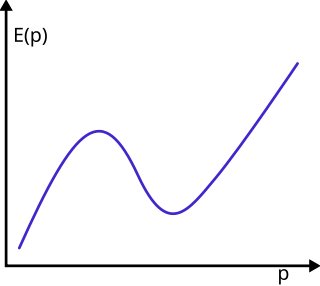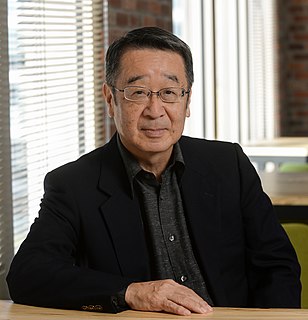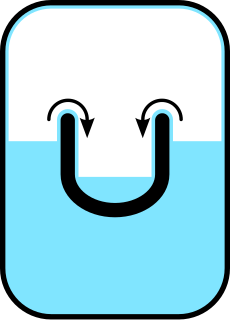Related Research Articles

In condensed matter physics, a Bose–Einstein condensate (BEC) is a state of matter that is typically formed when a gas of bosons at very low densities is cooled to temperatures very close to absolute zero. Under such conditions, a large fraction of bosons occupy the lowest quantum state, at which point microscopic quantum mechanical phenomena, particularly wavefunction interference, become apparent macroscopically. A BEC is formed by cooling a gas of extremely low density to ultra-low temperatures.
Superfluid helium-4 is the superfluid form of helium-4, an isotope of the element helium. A superfluid is a state of matter in which matter behaves like a fluid with zero viscosity. The substance, which looks like a normal liquid, flows without friction past any surface, which allows it to continue to circulate over obstructions and through pores in containers which hold it, subject only to its own inertia.

An exciton is a bound state of an electron and an electron hole which are attracted to each other by the electrostatic Coulomb force. It is an electrically neutral quasiparticle that exists in insulators, semiconductors and some liquids. The exciton is regarded as an elementary excitation of condensed matter that can transport energy without transporting net electric charge.

In physics, polaritons are quasiparticles resulting from strong coupling of electromagnetic waves with an electric or magnetic dipole-carrying excitation. They are an expression of the common quantum phenomenon known as level repulsion, also known as the avoided crossing principle. Polaritons describe the crossing of the dispersion of light with any interacting resonance. To this extent polaritons can also be thought of as the new normal modes of a given material or structure arising from the strong coupling of the bare modes, which are the photon and the dipolar oscillation. The polariton is a bosonic quasiparticle, and should not be confused with the polaron, which is an electron plus an attached phonon cloud.

In theoretical physics, a roton is an elementary excitation, or quasiparticle, seen in superfluid helium-4 and Bose–Einstein condensates with long-range dipolar interactions or spin-orbit coupling. The dispersion relation of elementary excitations in this superfluid shows a linear increase from the origin, but exhibits first a maximum and then a minimum in energy as the momentum increases. Excitations with momenta in the linear region are called phonons; those with momenta close to the minimum are called rotons. Excitations with momenta near the maximum are called maxons.

In condensed matter physics, a supersolid is a spatially ordered material with superfluid properties. In the case of helium-4, it has been conjectured since the 1960s that it might be possible to create a supersolid. Starting from 2017, a definitive proof for the existence of this state was provided by several experiments using atomic Bose–Einstein condensates. The general conditions required for supersolidity to emerge in a certain substance are a topic of ongoing research.

A fermionic condensate or Fermi–Dirac condensate is a superfluid phase formed by fermionic particles at low temperatures. It is closely related to the Bose–Einstein condensate, a superfluid phase formed by bosonic atoms under similar conditions. The earliest recognized fermionic condensate described the state of electrons in a superconductor; the physics of other examples including recent work with fermionic atoms is analogous. The first atomic fermionic condensate was created by a team led by Deborah S. Jin in 2003.
Ultracold atoms are atoms that are maintained at temperatures close to 0 kelvin, typically below several tens of microkelvin (µK). At these temperatures the atom's quantum-mechanical properties become important.

In physics, a quantum vortex represents a quantized flux circulation of some physical quantity. In most cases, quantum vortices are a type of topological defect exhibited in superfluids and superconductors. The existence of quantum vortices was first predicted by Lars Onsager in 1949 in connection with superfluid helium. Onsager reasoned that quantisation of vorticity is a direct consequence of the existence of a superfluid order parameter as a spatially continuous wavefunction. Onsager also pointed out that quantum vortices describe the circulation of superfluid and conjectured that their excitations are responsible for superfluid phase transitions. These ideas of Onsager were further developed by Richard Feynman in 1955 and in 1957 were applied to describe the magnetic phase diagram of type-II superconductors by Alexei Alexeyevich Abrikosov. In 1935 Fritz London published a very closely related work on magnetic flux quantization in superconductors. London's fluxoid can also be viewed as a quantum vortex.
A sonic black hole, sometimes called a dumb hole or acoustic black hole, is a phenomenon in which phonons are unable to escape from a region of a fluid that is flowing more quickly than the local speed of sound. They are called sonic, or acoustic, black holes because these trapped phonons are analogous to light in astrophysical (gravitational) black holes. Physicists are interested in them because they have many properties similar to astrophysical black holes and, in particular, emit a phononic version of Hawking radiation. This Hawking radiation can be spontaneously created by quantum vacuum fluctuations, in close analogy with Hawking radiation from a real black hole. On the other hand, the Hawking radiation can be stimulated in a classical process. The boundary of a sonic black hole, at which the flow speed changes from being greater than the speed of sound to less than the speed of sound, is called the event horizon.
Analog models of gravity are attempts to model various phenomena of general relativity using other physical systems such as acoustics in a moving fluid, superfluid helium, or Bose–Einstein condensate; gravity waves in water; and propagation of electromagnetic waves in a dielectric medium. These analogs serve to provide new ways of looking at problems, permit ideas from other realms of science to be applied, and may create opportunities for practical experiments within the analog that can be applied back to the source phenomena.
David W. Snoke is a physics professor at the University of Pittsburgh in the Department of Physics and Astronomy. In 2006 he was elected a Fellow of the American Physical Society "for his pioneering work on the experimental and theoretical understanding of dynamical optical processes in semiconductor systems." In 2004 he co-wrote a controversial paper with prominent intelligent design proponent Michael Behe. In 2007, his research group was the first to report Bose-Einstein condensation of polaritons in a trap. David Snoke and theoretical physicist Jonathan Keeling recently published an article announcing a new era for polariton condensates saying that polaritons are arguably the "...best hope for harnessing the strange effects of quantum condensation and superfluidity in everyday applications."
In quantum mechanics, macroscopic quantum self-trapping is when two Bose-Einstein condensates weakly linked by an energy barrier which particles can tunnel through, nevertheless end up with a higher average number of bosons on one side of the junction than the other. The junction of two Bose–Einstein condensates is mostly analogous to a Josephson junction, which is made of two superconductors linked by a non-conducting barrier. However, superconducting Josephson junctions do not display macroscopic quantum self-trapping, and thus macroscopic quantum self-tunneling is a distinguishing feature of Bose-Einstein condensate junctions. Self-trapping occurs when the self-interaction energy between the Bosons is larger than a critical value called .

Yoshihisa Yamamoto is the director of Physics & Informatics Laboratories, NTT Research, Inc. He is also Professor (Emeritus) at Stanford University and National Institute of Informatics (Tokyo).
A polariton laser is a novel type of laser source that exploits the coherent nature of Bose condensates of exciton-polaritons in semiconductors to achieve ultra-low threshold lasing.
In physics the Exciton–polariton is a type of polariton; a hybrid light and matter quasiparticle arising from the strong coupling of the electromagnetic dipolar oscillations of excitons and photons. Because light excitations are observed classically as photons, which are massless particles, they do not therefore have mass, like a physical particle. This property makes them a quasiparticle.

Superfluidity is the characteristic property of a fluid with zero viscosity which therefore flows without any loss of kinetic energy. When stirred, a superfluid forms vortices that continue to rotate indefinitely. Superfluidity occurs in two isotopes of helium when they are liquefied by cooling to cryogenic temperatures. It is also a property of various other exotic states of matter theorized to exist in astrophysics, high-energy physics, and theories of quantum gravity. The theory of superfluidity was developed by Soviet theoretical physicists Lev Landau and Isaak Khalatnikov.
Bose–Einstein condensation can occur in quasiparticles, particles that are effective descriptions of collective excitations in materials. Some have integer spins and can be expected to obey Bose–Einstein statistics like traditional particles. Conditions for condensation of various quasiparticles have been predicted and observed. The topic continues to be an active field of study.
Bose–Einstein condensation of polaritons is a growing field in semiconductor optics research, which exhibits spontaneous coherence similar to a laser, but through a different mechanism. A continuous transition from polariton condensation to lasing can be made similar to that of the crossover from a Bose–Einstein condensate to a BCS state in the context of Fermi gases. Polariton condensation is sometimes called “lasing without inversion”.
In condensed matter physics, the quantum dimer magnet state is one in which quantum spins in a magnetic structure entangle to form a singlet state. These entangled spins act as bosons and their excited states (triplons) can undergo Bose-Einstein condensation (BEC). The quantum dimer system was originally proposed by Matsubara and Matsuda as a mapping of the lattice Bose gas to the quantum antiferromagnet. Quantum dimer magnets are often confused as valence bond solids; however, a valence bond solid requires the breaking of translational symmetry and the dimerizing of spins. In contrast, quantum dimer magnets exist in crystal structures where the translational symmetry is inherently broken. There are two types of quantum dimer models: the XXZ model and the weakly-coupled dimer model. The main difference is the regime in which BEC can occur. For the XXZ model, the BEC occurs upon cooling without a magnetic field and manifests itself as a symmetric dome in the field versus temperature phase diagram centered about H = 0. The weakly-coupled dimer model does not magnetically order in zero magnetic field, but instead orders upon the closing of the spin gap, where the BEC regime begins and is a dome centered at non-zero field.
References
- ↑ Byrnes T, Kim NY, Yamamoto Y (2014). "Exciton–polariton condensates". Nature Physics. 10 (11): 803–813. arXiv: 1411.6822 . Bibcode:2014NatPh..10..803B. doi:10.1038/nphys3143. S2CID 118545281.
- ↑ Sanvitto D, Kéna-Cohen S (2016). "The road towards polaritonic devices". Nature Materials. 15 (10): 1061–1073. Bibcode:2016NatMa..15.1061S. doi:10.1038/nmat4668. PMID 27429208.
- ↑ R. Balili; et al. (2007). "Bose-Einstein Condensation of Microcavity Polaritons in a Trap". Science . 316 (5827): 1007–10. Bibcode:2007Sci...316.1007B. doi:10.1126/science.1140990. PMID 17510360. S2CID 2682022.
- ↑ Morgan Kelly. "Pitt Researchers Create New Form of Matter". University of Pittsburgh. Archived from the original on 2007-05-25. Retrieved 2007-05-31.
- ↑ Amo, Alberto; Lefrère, Jérôme; Pigeon, Simon; Adrados, Claire; Ciuti, Cristiano; et al. (2009-09-20). "Superfluidity of polaritons in semiconductor microcavities". Nature Physics. 5 (11): 805–810. arXiv: 0812.2748 . Bibcode:2009NatPh...5..805A. doi: 10.1038/nphys1364 . ISSN 1745-2473.
- ↑ Jacek Kasprzak (2006). "Condensation of exciton polaritons" (PDF). Université Joseph Fourier - Grenoble I.
- ↑ Hui Deng (2006). "Dynamic Condensation of Semiconductor Microcavity Polaritons" (PDF). Stanford University.
- ↑ Cancellieri, E.; Marchetti, F. M.; Szymańska, M. H.; Tejedor, C. (2010). "Superflow of resonantly driven polaritons against a defect". Phys. Rev. B. 82 (224512): 224512. arXiv: 1009.3120 . Bibcode:2010PhRvB..82v4512C. doi:10.1103/PhysRevB.82.224512. S2CID 118458289.
- ↑ Pinsker, F. (2017). "Beyond superfluidity in non-equilibrium Bose–Einstein condensates". New Journal of Physics. 19 (113046): 113046. arXiv: 1611.03430 . Bibcode:2017NJPh...19k3046P. doi:10.1088/1367-2630/aa9561. S2CID 119076087.
- ↑ D. Sanvitto; et al. (2010). "Persistent currents and quantized vortices in a polariton superfluid". Nature Physics . 6 (7): 527–533. arXiv: 0907.2371 . Bibcode:2010NatPh...6..527S. doi:10.1038/nphys1668. S2CID 119278255.
- ↑ A. Amo; et al. (2009). "Superfluidity of polaritons in semiconductor microcavities". Nature Physics . 5 (11): 805–810. arXiv: 0812.2748 . Bibcode:2009NatPh...5..805A. doi:10.1038/nphys1364. S2CID 56339602.
- ↑ G. Lerario; et al. (2017). "Room-temperature superfluidity in a polariton condensate". Nature Physics . online ed. (9): 837–841. arXiv: 1609.03153 . Bibcode:2017NatPh..13..837L. doi:10.1038/nphys4147. S2CID 119298251.